Maximizing Windows 11 Performance on Tower PCs
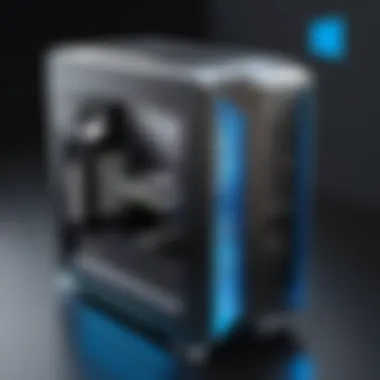
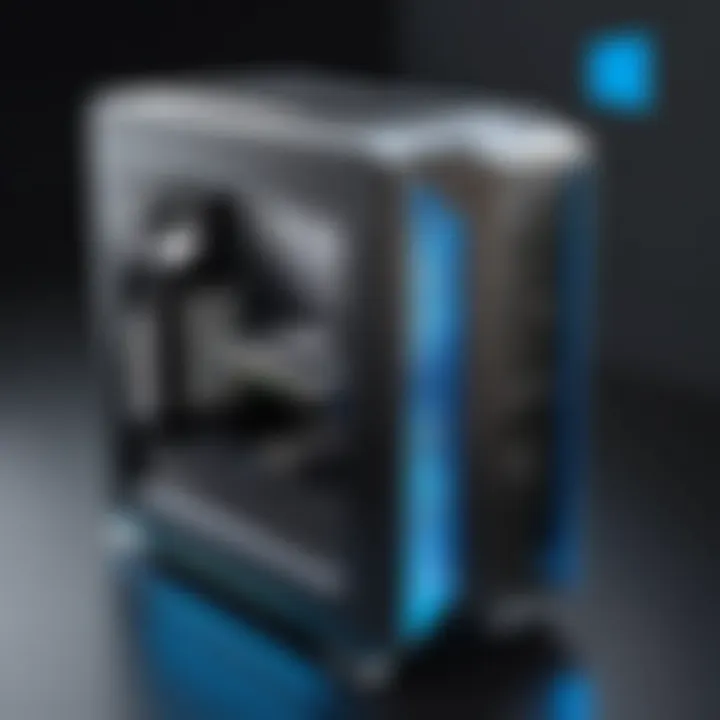
Product Overview
Windows 11 represents a significant leap in the desktop operating system landscape, particularly when deployed on tower PCs. This operating system is designed to enhance productivity, improve user experience, and integrate more seamlessly into digital lifestyle of users.
Key Features and Specifications
Windows 11 comes with a more refined user interface than its predecessor, Windows 10. Among its fundamental features are:
- New User Interface: A centered taskbar, revamped Start menu, and rounded corners give a modern aesthetic.
- Performance Improvements: Enhanced speed for boot times and running applications.
- Virtual Desktops: Customized desktops for different workloads.
- Gaming Advancements: DirectStorage and Auto HDR capabilities enhance gaming performance and experience.
- Snap Layouts: Facilitates multitasking by allowing users to arrange open windows efficiently.
- Widgets: Personalized news and content updates available at a glance.
The system requirements have shifted compared to Windows 10, mandating the need for compatible hardware. Users should ensure their tower PCs meet these specifications to utilize Windows 11 effectively.
Performance and User Experience
Hands-on testing has revealed that Windows 11 delivers impressive performance on tower PCs equipped with sufficient RAM and modern processing power. Users report quicker application launch times and smooth transitions between tasks.
The user interface has been tested for ease of use. The centered taskbar and redesigned Start menu streamline functionality. Navigating through settings is straightforward, making it accessible even for non-technical users.
When comparing with similar operating systems, Windows 11 stands out for its focus on aesthetic and enhanced user experience. While other systems may offer similar functionality, Windows 11’s integration of user feedback into design decisions provides a unique advantage.
Design and Build Quality
An important aspect of Windows 11 is its design. The operating system opts for a cleaner interface, moving away from the cluttered options that characterized earlier versions.
Materials such as acrylic for some UI elements contribute to its durability while maintaining a sleek appearance. Ergonomics are also well-considered, as most settings and tools are easily accessible, minimizing navigation frustrations.
This design ethos reflects a shift towards a more modern operating system suited for both work and leisure, indicating a focus on aesthetics without sacrificing functionality.
Technology and Innovation
Windows 11 incorporates several groundbreaking technologies. DirectStorage, for example, allows for faster asset loading in games by enabling data to be loaded directly to the graphics card.
This is a significant advancement in gaming technology, potentially reshaping user expectations for loading times and in-game performance. Such innovations not only enhance current consumer experiences but also set the stage for future developments in gaming and overall computing efficiency.
Pricing and Value Proposition
Considering the value it provides, Windows 11’s pricing is competitive. The costs associated with upgrading systems align well with the enhanced capabilities that the operating system brings.
Moreover, compared against competitors like macOS and various Linux distributions, Windows 11’s value proposition remains appealing, balancing functionality, design, and cost.
Prolusion to Windows
Windows 11 marks a significant step in Microsoft’s evolution of its operating systems, tailored specifically for contemporary computing needs. Its design and functionalities focus on enhancing user experience, efficient productivity, and seamless compatibility with modern hardware, particularly tower PCs. Understanding Windows 11 in depth is crucial for anyone interested in maximizing their desktop environments, and this article will explore its implications in detail.
The importance of Windows 11 is highlighted through various elements, such as a refreshed interface, enhanced gaming capabilities, and improved security features. These changes are not superficial; they cater to the needs of both casual users and tech enthusiasts. As people increasingly depend on their computers for work and play, Windows 11 offers a robust platform that is adaptable to diverse user requirements.
Overview of Windows Features
Windows 11 introduces several notable features that focus on user interface and overall performance. Some key features include:
- New Start Menu: The Start Menu is centered, creating a more organized look. It simplifies access to apps and settings.
- Snap Layouts: This allows users to manage multiple open windows more efficiently. The settings make multitasking streamlined, a necessary feature for power users.
- Widgets: These provide personalized information at a glance, such as weather updates or news highlights, catering to individual preferences.
- Gaming Enhancements: With direct integration of Xbox technologies, Windows 11 offers enhanced gaming experiences, allowing for higher frame rates and better graphics performance.
These features are designed not just to attract new users, but also to retain seasoned ones who expect continuous innovations and improvements.
Historical Context and Evolution
The context of Windows 11 involves a long journey of development and adaptation to the user’s changing needs. Initially launched in 1985, Windows has undergone numerous transformations influenced by both technological advances and user feedback.
Each iteration has introduced significant changes. Windows 10, for instance, streamlined user experience but remained somewhat tethered to its legacy. Windows 11, on the other hand, comes at a time when users demand faster, more efficient systems that resonate with modern aesthetics. Features like virtual desktops, improved touch screen capabilities, and integration of cloud services highlight this evolutionary trend.
Ultimately, recognizing this historical backdrop can help users appreciate the innovations in Windows 11 as both a culmination of past lessons and a transformative step toward the future.
"Understanding the evolution of Windows helps to contextualize the robust functionality of Windows 11, especially in optimizing tower PC performance."
In summary, Windows 11 presents a compelling operating system aimed at enhancing user experience, with features designed for optimal performance on tower PCs.
System Requirements for Windows
Understanding the system requirements for Windows 11 is crucial for any user looking to install this operating system on a tower PC. The requirements ensure not only compatibility but also performance. Users must assess their current hardware and determine whether they need upgrades to fully benefit from Windows 11. Properly meeting these requirements can vastly improve user experience, enhance security features, and optimize general performance. This section aims to clarify both the minimum specifications needed and the recommended configurations for those looking for optimal performance.
Minimum Hardware Specifications
The minimum hardware specifications for Windows 11 serve as the foundation for any installation. According to Microsoft, users must have a compatible 64-bit processor with at least 1 GHz clock speed. Moreover, a minimum of 4 GB RAM is required along with 64 GB of storage space. While these specifications may seem sufficient for basic functionality, they often do not allow users to experience the full capabilities of Windows 11.
The importance of these minimum specifications lies in the base functionality they offer. For example, a compatible processor ensures that the user can run Windows 11 and other applications effectively. However, users should note that meeting these minimum standards may lead to sluggish performance and slow response times during resource-intensive tasks.
Recommended Configurations for Optimal Performance
To take full advantage of Windows 11 features, users should aim for recommended configurations that exceed the minimum specifications. Specifically, this includes a faster processor, increased RAM, and additional storage options. Here, we will discuss each of these elements in more detail to understand their significance.
Processor Requirements
When it comes to processor requirements, a more capable CPU significantly impacts overall system performance. A quad-core processor with a speed of 2.0 GHz or higher is generally regarded as best practice for smooth multitasking and efficient operation.
Highlighting the Intel Core i5 or AMD Ryzen 5 processors, these options provide a balance between performance and cost. They offer integrated graphics as well as support for gaming and content creation. Choosing a stronger CPU minimizes lag during peak usage, ensuring a seamless user experience. On the downside, more powerful processors can also lead to increased energy consumption.
RAM and Storage Recommendations
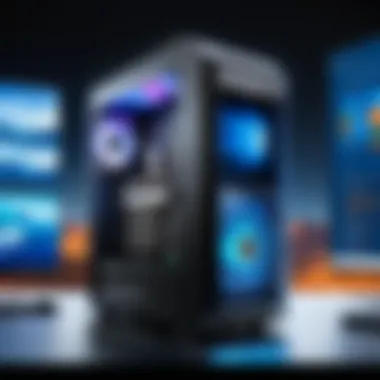
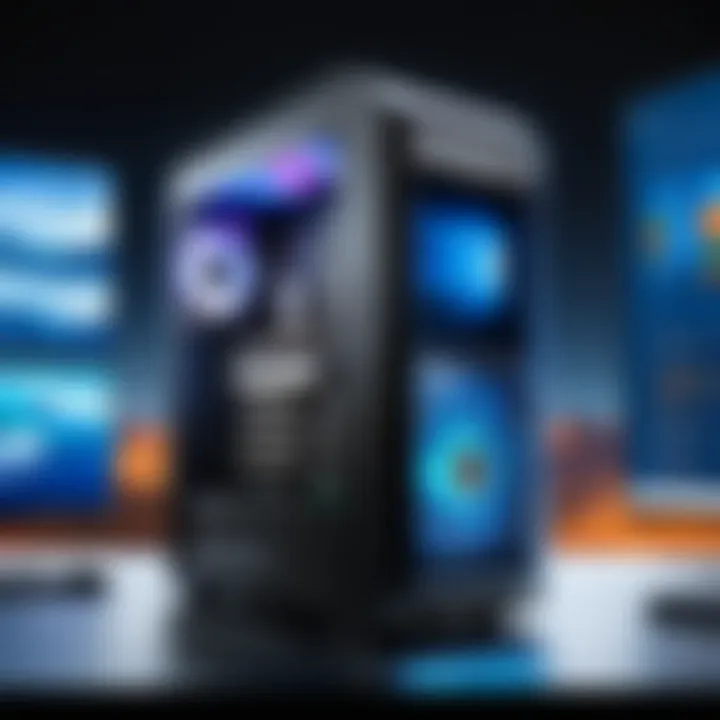
For optimal performance in Windows 11, 16 GB of RAM is often recommended. This amount allows multiple applications to run smoothly and reduces the likelihood of system slowdowns.
In terms of storage, a solid-state drive (SSD) is highly advantageous compared to traditional hard drives. SSDs allow faster boot times and quicker file access, which improves overall system responsiveness. While SSDs are generally more expensive per gigabyte, the performance benefits outweigh the costs in most scenarios. On the negative side, users with limited budgets may find it challenging to upgrade to these preferred specifications.
Graphics Support
Graphics support plays a vital role in the performance of Windows 11, especially for users interested in gaming or graphic design. For the best experience, a dedicated graphics card such as the NVIDIA GeForce GTX 1650 or AMD Radeon RX 5500 is recommended. These cards provide the necessary processing power for handling graphically intense applications.
Integrated graphics may suffice for basic tasks but are generally insufficient for more demanding applications. Investing in a dedicated GPU can lead to a significant uplift in performance, helping users unlock capabilities that Windows 11 offers. However, the upfront cost of dedicated graphics solutions can be prohibitive.
In summary, ensuring that system requirements for Windows 11 are met is essential for a satisfactory experience. Users should assess their hardware specifications against both minimum and recommended configurations to achieve optimal performance conditions.
Tower PC Hardware Considerations
When discussing Windows 11 and its operation on tower PCs, one cannot overlook the significance of hardware considerations. The hardware architecture of a tower PC will directly influence performance, stability, compatibility, and user experience. Selecting the right components is essential to fully leverage the features offered by Windows 11. It is not just about meeting the minimum requirements; optimal configurations can enhance productivity and enjoyment.
Best Tower PC Models for Windows
In exploring suitable tower PC models for Windows 11, it is crucial to assess machines that can handle the demands of this operating system effectively. Here are some top choices:
- Dell XPS Tower: Known for its sleek design and powerful internals, this model offers excellent performance, especially with Intel i7 processors.
- HP Omen Series: Targeting gamers and power users alike, the Omen series offers high-end performance while supporting extensive upgrades.
- Lenovo Legion Tower: With impressive cooling solutions and expandability, the Legion Tower is well-suited for demanding applications.
- Acer Aspire TC: A more budget-friendly option, yet it provides reliable performance for day-to-day tasks without sacrificing features.
Each of these models meets the core requirements for Windows 11 and brings its unique set of strengths and features. Their configurations may include advanced GPUs, fast SSDs, and ample RAM, all crucial for optimal experiences.
Building vs. Buying a Tower PC
The decision to build or buy a tower PC is pivotal for many users looking to run Windows 11. Building your own PC allows for customization. You can select every component based on personal preferences and performance needs, which can be advantageous.
- Advantages of Building:
- Disadvantages of Building:
- Customization to fit specific needs.
- Potentially lower costs compared to pre-built machines.
- Learning opportunity about technology.
- Higher upfront time investment for research and assembly.
- Troubleshooting potential hardware problems without warranty support.
In contrast, buying a pre-built tower PC saves time. It may also offer manufacturer warranties, which provide peace of mind.
- Advantages of Buying:
- Disadvantages of Buying:
- Immediate usability with no assembly needed.
- Support and warranty from manufacturers.
- Tested compatibility of components.
- Limited customization options.
- Possible premium cost for the convenience.
Ultimately, the choice between building and buying heavily depends on individual needs, preferences, and technical comfort. Either path can lead to an effective setup for running Windows 11.
Installation Process of Windows
The installation process of Windows 11 is crucial for harnessing the advanced functionalities that the operating system offers. A smooth installation can set the stage for reliable performance and enhanced user experience. Understanding the necessary steps, along with the prerequisites, is vital for any tech-savvy individual or gadget lover who aims to optimize their tower PC setup. This section will cover the installation prerequisites while guiding readers through the step-by-step installation process. Having a well-defined procedure can lead to less downtime and eventually contribute positively to overall productivity.
Installation Prerequisites
Before embarking on the installation journey, a few essential prerequisites must be in place. First, ensure that the hardware meets the necessary specifications outlined for Windows 11. This includes a compatible processor, sufficient RAM, and available storage space. The system should also support Secure Boot and TPM version 2.0 for enhanced security. Another crucial aspect of prerequisites is the availability of installation media. Users must possess either a USB drive or an ISO file to initiate the installation process.
It is important to back up data before starting the installation. This step can safeguard against any unexpected issues that may lead to data loss. By ensuring all prerequisites are satisfied, the installation can proceed effectively, paving the way for a smoother transition to Windows 11.
Step-by-Step Installation Guide
Preparing Installation Media
Preparing the installation media is a critical first step in the Windows 11 installation process. A USB drive is commonly used, preferred for its speed and convenience. To create this media, users can utilize the Windows Media Creation Tool, which streamlines the process significantly. This tool provides a guided interface, allowing even less experienced users to create a bootable USB drive effectively.
The key characteristic of using installation media is its ability to provide a clean slate for installation. This is particularly beneficial when upgrading from older versions or resolving extensive software issues. However, it is essential to ensure that the media is created correctly. An improperly made installation media can lead to failed installations or, worse, an unusable system.
Executing Installation
Executing the installation itself marks a significant step in utilizing Windows 11 features. After booting from the installation media, users are guided through a series of prompts to set preferences and select installation options. This part of the process allows for customization according to individual needs.
One widely recognized characteristic of this execution phase is its relatively intuitive design. Users can choose between a clean installation or an upgrade without losing their files. Moreover, Windows 11's straightforward approach makes it a popular choice, minimizing anxiety often associated with new software installations. Always ensure connections like power and peripherals are secure to avoid interruptions during this process, which can cause problems or data corruption.
Post-Installation Setup
After the installation is complete, users enter the post-installation setup phase. This step is significant for configuring settings to match personal preferences and enhance user experience. Here, one may set up user accounts, adjust privacy settings, and personalize interface features, such as themes and layouts.
The unique feature of post-installation setup is that it can help tailor the environment to maximize productivity or leisure activities. This aspect is particularly useful for early adopters and gamers alike, who may have specific workflows or needs. However, new users should proceed cautiously. A misconfiguration at this stage could lead to functionality issues later on.
By following these installation process steps, users can fully appreciate the robust capabilities of Windows 11 on their tower PCs. Ensuring a careful installation leads to a more stable and performance-oriented computing experience.
User Interface Changes in Windows
The user interface (UI) changes in Windows 11 represent a significant leap toward enhancing user engagement and productivity. Windows 11 reimagines the layout and design of its predecessors, making crucial adjustments in various segments while remaining user-friendly. For tech-savvy individuals, understanding these changes is vital, as it not only impacts usability but also the overall performance when running applications on tower PCs. A smooth and intuitive interface helps in better interaction with complex software, contributing to efficiency.
Overview of the New Start Menu
The Start Menu in Windows 11 has undergone one of the most noticeable overhauls in this version. Gone is the traditional look, replaced by a centered layout that promotes accessibility. This design change embraces a more streamlined and app-centric approach.
Key features of the new Start Menu include:
- Recommended section: Users can quickly access recently used files and applications. This section boosts productivity by minimizing time spent searching for commonly used tools.
- Pinned applications: Users can easily customize which apps appear in this area, making it simpler to work with frequently used programs. The drag-and-drop functionality further enhances convenience.
- Search functionality: Directly integrated into the Start Menu, search options allow users to swiftly locate applications, files, or settings. This improvement means less time navigating through multiple menus.
Overall, the new Start Menu not only modernizes the look but also enhances functionality, making it a practical component of the user experience for tower PC users.


Taskbar and Window Management
Windows 11 introduces notable advancements in taskbar and window management, centering on accessibility and ease of use. The taskbar is now simplified, featuring an optimized layout that aligns apps in the center by default, though users can still adjust this to their preference.
Key components of taskbar improvements include:
- Snap layouts: This feature allows for quick arrangement of windows into predefined layouts. Users can easily split screens and manage multiple apps without clutter, perfect for multitasking.
- Group features: Users can organize active windows into groups, making it easier to switch between tasks efficiently. This function is particularly beneficial for power users who often work on various projects simultaneously.
- Improved notification center: The taskbar integrates notifications more effectively, allowing users to check updates without diverting attention from current activities. This subtle change increases productivity and decreases disruptions.
These enhancements in taskbar and window management complement the tower PC experience, facilitating smooth transitions between tasks while maintaining an uncluttered desktop.
Settings Navigation Enhancements
The settings menu in Windows 11 has been reorganized to improve the user experience significantly. A more intuitive navigation structure allows users to locate preferences quicker than in prior versions.
Notable enhancements include:
- Categories and Subcategories: The new layout organizes settings into broad categories that dive deeper as needed. Users can easily find sound, display, and privacy settings without getting lost.
- Search capability: A powerful search function within Settings allows users to type keywords and quickly access relevant settings, eliminating the frustration of endless scrolling.
- Integrated help and tips: The settings menu now features contextual tips that guide users through the configuration process. This helps especially those who might be less tech-savvy yet want to customize their environment.
Windows 11's Settings navigation improvements mark a shift toward user-centered design, ensuring that all users can maximize their tower PC's potential.
In summary, the user interface changes within Windows 11 significantly improve how users interact with their systems on tower PCs. From the revamped Start Menu to enhanced taskbar functions and simplified settings navigation, each alteration is aimed at elevating user experience and productivity.
Performance Optimizations
Performance optimizations are essential to maximize the efficacy of Windows 11 on tower PCs. With the evolving landscape of applications and tasks, having an optimized system ensures responsiveness and reduced downtime. This section will delve into various strategies and tools available to boost performance, focusing particularly on startup optimization and leveraging hardware capabilities.
Optimizing Startup and Resource Usage
Startup optimization is a crucial step in enhancing the overall speed and efficiency of a tower PC running Windows 11. When the computer boots up, various applications and services want to load, which can result in increased boot times and resource consumption. To address this:
- Disable Unnecessary Startup Programs: Many applications set themselves to launch during boot time. Users can access the Task Manager and identify startup programs that are not essential. Disabling these can significantly speed up boot times.
- Utilize Fast Startup Feature: Windows 11 includes a Fast Startup feature that combines hibernation and shutdown, allowing a quicker boot-up process.
- Manage Services: Some background services may be unnecessary for daily tasks. By managing these in the Services application, users can streamline performance at startup.
By implementing these steps, users not only improve speed but can also reduce the overall resource usage of the system, leading to a more efficient operating environment.
Leveraging Hardware Acceleration
Hardware acceleration plays a vital role in enhancing the performance of Windows 11 by offloading certain tasks to specific hardware components rather than relying solely on the CPU. Using hardware capabilities effectively can lead to smoother operation and better results in demanding applications.
Graphics Processing Unit (GPU)
The Graphics Processing Unit (GPU) is integral to performance optimization, especially for visually intensive applications and gaming. A key characteristic of modern GPUs is their ability to handle parallel processing. This makes them particularly effective at executing multiple tasks simultaneously, such as rendering complex graphics or video processing.
One unique feature of many GPUs, such as NVIDIA's RTX series, is ray tracing. This technology simulates realistic lighting and reflections, enhancing visual fidelity. It can significantly improve the gaming experience on Windows 11 by delivering immersive graphics that were previously not possible.
Advantages of utilizing a powerful GPU:
- Enhanced Gaming Experience: Higher frame rates and better graphics performance.
- Improved Multimedia Tasks: Editing videos or photos becomes smoother and more efficient.
However, a disadvantage may include increased power consumption and heat generation, which requires adequate cooling solutions.
Central Processing Unit (CPU)
The Central Processing Unit (CPU) is the heart of the tower PC, and its role in performance optimization cannot be overstated. A modern CPU, like AMD Ryzen 5000 series or Intel Core i7, boasts multiple cores and threads that allow for efficient multitasking.
A standout feature of advanced CPUs is hyper-threading, which enables each core to split tasks, effectively doubling performance on certain workloads. This is particularly beneficial in a Windows 11 environment where productivity applications and background tasks often operate simultaneously.
Some benefits of having a powerful CPU are:
- Quick Load Times: Faster processing means quicker access and execution of applications.
- Fluid Multitasking: The ability to run multiple demanding applications without significant lag.
On the downside, advanced CPUs can require more power and can be more expensive, which could lead to higher system costs.
Security Features in Windows
Security is a critical aspect of any operational system, especially in a time where cyber threats grow more complex and pervasive. Windows 11 has integrated robust security features designed to protect users' data and privacy. This article explores two central elements of Windows 11 security: Windows Hello and Biometric Authentication, and Virtualization-based Security. By understanding these features, users can appreciate the enhanced security measures that Windows 11 offers, particularly on tower PCs where power and performance marry security seamlessly.
Windows Hello and Biometric Authentication
Windows Hello presents an innovative way to log into devices using biometric recognition. This feature enables users to unlock their PC with facial recognition, fingerprint scanning, or even a PIN code. The significance of biometric authentication lies in its ability to enhance security while providing greater convenience. Since biometric data is unique to each user, it is much harder for unauthorized users to gain access.
- Benefits of Windows Hello:
- Enhanced Security: Traditional passwords can be stolen or guessed. In contrast, biometric data offers a more secure alternative.
- User Convenience: Logging in via biometric means is faster than entering passwords, especially for frequently used devices.
- Privacy: Windows Hello stores biometric data locally, not on a server, which minimizes the risk of data breach.
Implementing Windows Hello can greatly reduce the risk of cyber theft and unauthorized access. Devices that meet the requirements for this feature can greatly benefit from its capabilities, reinforcing the overall security framework of Windows 11.
Virtualization-based Security
Virtualization-based Security (VBS) is another compelling feature in Windows 11. VBS employs virtualization technology to create a secure environment isolated from the main operating system. This helps in protecting sensitive code and data from potential threats. With VBS, components like Credential Guard and Device Guard operate more effectively.
"Virtualization-based Security provides an innovative barrier against malware, enhancing the overall security infrastructure".
- Key Aspects of VBS:
- Isolation: It prevents malicious code from affecting core operating system processes.
- Credential Guard: This feature guards user credentials, making it considerably harder for attackers to use stolen credentials.
- Integration: VBS is compatible with many existing security features and enhances their efficacy, offering a more cohesive security solution.
In summary, the security features in Windows 11, such as Windows Hello and VBS, are not just improvements but essential elements designed to confront modern challenges in digital security. Understanding these features provides tower PC users with a clearer picture of how Windows 11 can safeguard their system from threats.
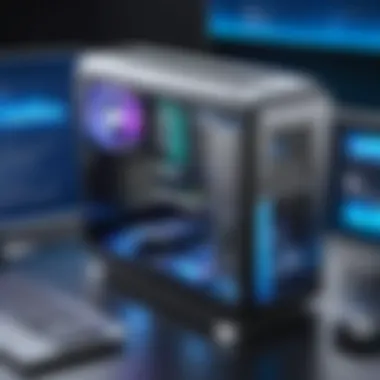
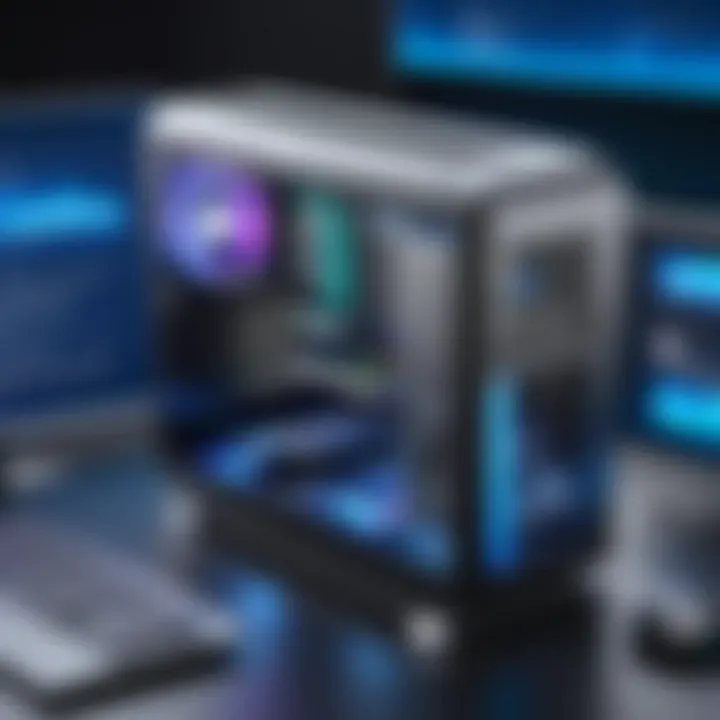
Software Compatibility and Applications
In the realm of technology, software compatibility is a critical factor that can make or break the user experience on any operating system. For Windows 11, running on tower PCs, this holds significant relevance. The diverse software ecosystem allows users to leverage powerful applications for work, entertainment, and creative tasks. To maximize these benefits, it is essential to understand how compatibility plays into both legacy applications and optimized apps specifically designed for Windows 11.
Effective software compatibility contributes to a seamless experience. Users expect their familiar tools to work without major hitches. Additionally, the introduction of new applications tailored for the latest operating system can enhance performance and efficiency. This balance of old and new is key to achieving optimum productivity.
Legacy Application Support
Legacy applications are programs designed for earlier operating systems. These might include essential business software or creative tools that users rely upon. Windows 11 includes features that enable these applications to run effectively, ensuring continuity for organizations that have invested heavily in specific software solutions.
The compatibility layer in Windows 11 allows many legacy applications to run without requiring major modifications. Users may find that their time-tested software does not just operate but performs surprisingly well. This is a significant advantage for those who are reluctant to transition entirely to new systems. Being able to utilize existing tools without disruption can save valuable time and resources. However, it is still important to regularly check for updates from the developers to maintain security and functionality.
Optimized Apps for Windows
Optimized applications are purpose-built to take advantage of the architecture and features of Windows 11. These apps often boast improved performance, user interfaces, and compatibility with newer hardware. With the increased focus on gaming, productivity, and creativity, optimized apps are becoming more popular among users.
Microsoft Store Offerings
Microsoft Store plays a vital role in distributing applications designed for Windows 11. Its key characteristic is the curated selection of applications that have been tested for compatibility with the latest OS. This makes it a beneficial choice for users looking to enhance their experience without the worry of software instability.
One unique feature of the Microsoft Store is its integration with Windows 11 features, such as Widgets and DirectStorage, which enhance performance for gaming applications. The advantage is clear: users can quickly find and install apps that are optimized for their system, saving time and effort in the process. However, some may argue that the selection, though curated, can be limited compared to downloading directly from developers’ websites.
Third-party Software
Third-party software encompasses any applications not distributed via the Microsoft Store. This could include popular tools like Zoom, Adobe Creative Cloud, and various utilities tailored for specific tasks. The appeal of third-party software lies in its diversity and the wide range of options available to users.
A substantial key characteristic of third-party software is its flexibility. Many applications offer features that complement Windows 11’s native tools and can provide unique solutions to users. For instance, a product like Slack may enhance collaboration in a way that built-in tools do not. However, using third-party applications necessitates careful consideration regarding security and ongoing support, as not all applications receive regular updates.
Ultimately, understanding the offerings in both the Microsoft Store and through third-party avenues allows users to make informed decisions that will enrich their experience on Windows 11. Embracing the full spectrum of software options available will ensure that tower PC users can achieve maximum efficiency, leveraging both legacy applications and innovative new tools as they navigate this new operating system.
Gaming on Windows Tower PCs
Gaming has become a prominent aspect of modern computing. When combined with Windows 11, tower PCs present a unique opportunity for gamers. This section aims to illuminate key features of Windows 11 that enhance gaming experiences, including optimizations specifically designed for high performance and seamless integration with gaming services.
Game Performance Enhancements
Windows 11 brings several enhancements to gaming performance, which are crucial for tower PC users. The new operating system takes advantage of advanced gaming technologies to optimize graphics and reduce latency. Features such as DirectStorage and Auto HDR are pivotal in this context.
- DirectStorage allows games to load assets directly from the SSD to the GPU, significantly reducing load times. This leads to a smoother gameplay experience, particularly in large open-world games where quick asset streaming is essential.
- Auto HDR enhances the dynamic range of visuals without requiring developers to modify existing titles. This feature improves overall image quality, leading to richer colors and better contrasts, especially in older games that may not have been designed for high dynamic range.
- Windows 11 also supports Variable Refresh Rate (VRR), which synchronizes the refresh rate of the monitor with the game’s frame rate, reducing screen tearing and providing an overall more fluid visual output.
When configuring tower PCs for gaming, it is essential to have the right mix of hardware. A powerful GPU, sufficient RAM, and fast SSDs are needed to fully utilize these enhancements. The right combination allows for high frame rates and superior graphical fidelity.
Integration with Xbox Services
An important dimension of the gaming experience on Windows 11 is its seamless integration with Xbox Services. The ability to access Xbox Game Pass and play games on multiple devices fosters a versatile gaming environment. With Xbox Game Pass for PC, users gain access to a vast library of games, from AAA titles to indie gems, all available at their fingertips.
- Cloud Gaming is another critical aspect, allowing users to play games via the cloud on their tower PCs or other devices. This democratizes gaming, eliminating the need for high-end hardware for every device.
- Furthermore, the Xbox app on Windows 11 simplifies the process of managing games, friends, and achievements. It serves as the hub where gamers can monitor their gaming activities efficiently.
- Enabling cross-play features enhances multiplayer experiences, allowing gamers on different platforms to compete together. This is particularly vital in today's gaming landscape, where community and accessibility are key drivers.
"Windows 11 merges convenience with advanced gaming technology, setting a new standard for tower PC gaming."
Overall, the confluence of performance enhancements and Xbox services showcases why Windows 11 is positioned as a superior platform for gaming on tower PCs. These factors combine to create a robust and engaging gaming experience for players seeking both quality and convenience.
Troubleshooting Windows on Tower PCs
Troubleshooting Windows 11 on tower PCs is an essential part of ensuring a smooth computing experience. As with any operating system, users may encounter various issues during installation or while using Windows 11. Understanding common problems and their solutions not only saves time but also enhances performance and longevity of the system. The focus here is to equip users with knowledge that enables them to resolve challenges independently and efficiently, thus maximizing the functionality of their tower PCs.
Common Installation Issues
Installation can be the first hurdle for many when transitioning to Windows 11. Common issues may arise, affecting the success of installation.
- Incompatible Hardware: Users must ensure that their tower PC meets the minimum hardware specifications. If the CPU or RAM falls short, the installation will not proceed. Check that you have at least 4GB of RAM and a compatible 64-bit processor.
- Secure Boot Requirement: Windows 11 demands that Secure Boot is enabled in the BIOS settings. Users often overlook this option, leading to installation failures.
- TPM 2.0 Missing: Trusted Platform Module version 2.0 is also a prerequisite. Its absence will block the installation, resulting in errors.
Checking these aspects beforehand can save frustration. If errors occur during installation, reviewing the logs can provide insights into specific problems.
Performance-related Troubleshooting
Once installed, users may face ongoing performance-related challenges. Recognizing and addressing these issues is vital for a seamless experience.
- Slow Boot Times: Slow startup can be a sign of conflicting applications or insufficient resources. Disable unnecessary startup programs through the Task Manager to speed up the process. Additionally, periodically clearing temporary files can help maintain optimal performance.
- Application Crashes: Software compatibility can be an issue. If an application does not run correctly, ensure it is the latest version. Windows Update may offer patches that resolve many issues.
- System Overheating: Regularly check device temperatures, as overheating can lead to throttled performance. Ensure that fans are working properly and that air vents are clear of dust.
- Resource Monitoring: Use the Task Manager to identify applications that might be using excessive CPU or memory resources. Uninstall or limit the use of these applications as needed.
Regular maintenance and monitoring of system performance can significantly improve user experiences with Windows 11 on tower PCs.
Understanding troubleshooting techniques equips tech-savvy individuals with the tools to manage and resolve common issues, ultimately leading to a more productive and enjoyable computing journey.
Future Trends and Developments in Windows
Understanding the future trends and developments in Windows 11 is crucial for users interested in maximizing their experience on tower PCs. The operating system landscape is continually evolving, and Microsoft aims to stay at the forefront of technology advancements. The upcoming changes and updates will not only enhance system performance but also improve security, usability, and overall functionality. Recognizing these trends enables users to prepare for these changes and effectively adapt their hardware and software environments.
Expected Updates and Feature Releases
Microsoft has a history of releasing regular updates for its operating systems, and Windows 11 is no exception. These future updates promise to refine existing features while introducing innovative capabilities. Some anticipated enhancements include:
- User Interface Improvements: Continued adjustments to the user interface are expected to optimize user interaction, making existing features even more intuitive.
- Enhanced Compatibility: Updates are likely to offer better support for various applications, focusing on gaming and productivity tools. This can ensure that users can take full advantage of their hardware resources.
- Artificial Intelligence Integration: With the rise of AI technologies, it is probable that Windows 11 will integrate AI-driven features. This could enhance productivity tools and user personalization.
- Gaming Enhancements: Building on prior updates, users can anticipate new gaming features, possibly including improved graphics support and better integration with cloud gaming services.
These updates will go a long way in keeping Windows 11 relevant and competitive in a fast-evolving tech landscape.
Long-term Support and Lifecycles
Long-term support for Windows 11 is essential for businesses and individual users alike, providing assurance that the system will receive critical updates and security patches for an extended period. Microsoft previously adopted a Windows-as-a-Service model, and while elements of this may continue, Windows 11 aims to strike a balance between new features and stability. Some considerations include:
- User Assurance: Knowing that Windows 11 will be supported for years allows users to invest in compatible hardware without the fear of obsolescence.
- Regular Updates: Microsoft commits to delivering ongoing updates that keep Windows 11 secure and efficient. This means users can benefit from new technologies without needing a complete system overhaul.
- Transition Plans: As the lifecycle of older operating systems conclude, users will have structured migration paths to Windows 11, ensuring a smooth transition with minimized disruption.
The long-term support offered by Microsoft can add significant value for organizations that rely on Windows 11 for critical operations.
In summary, the future trends and developments surrounding Windows 11 indicate a dedicated focus on enhancing user experience, security, and application support. By staying informed about these expected updates and understanding the importance of long-term support, tower PC users can navigate the landscape of Windows 11 with confidence.



